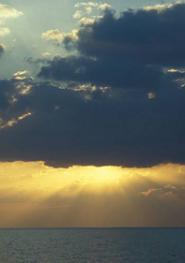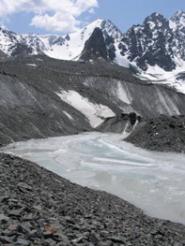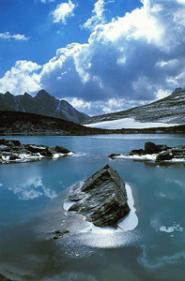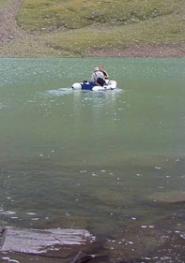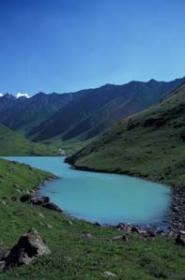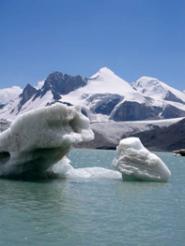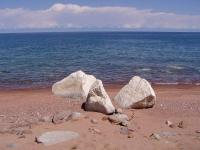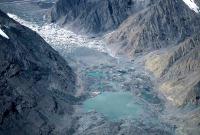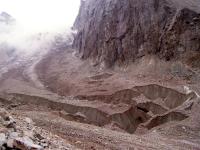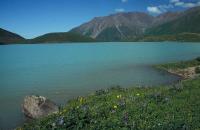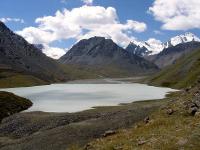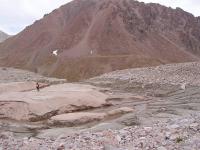ALPINE LAKES IN KYRGYZSTAN
TYPES OF ALPINE LAKES IN KYRGYZSTAN
The alpine lakes in the territory of Kyrgyzstan can be classified into several types and subtypes. The criterion for such classification includes their genesis and related morphological features. The degree of dangerousness of individual types and their susceptibility to failure and sudden breakout of water depend on the stage of lakes development, position and character of discharge.
Classification of dangerousness of lakes that are likely to fail
Phenomena influencing the lakes failure
Phenomena influencing the lakes failure
Tectonic lakes develop in intermontane and intramount depressions. These lakes are of large size and volume. All the major Kyrgyz lakes belong to this category: Issyk-Kul, Chatyn-Kul a Son-Kul. The first two lakes are undrained and the danger of dam failures does not exist.
Thermokarst lakes
These lakes originate on the surface of the existing glaciers in thermokarts funnels and depressions. Marginal parts of glaciers appear to be most suitable for their formation. Volumes of these lakes attain a few tens of thousands of cubic meters. Their dams contain numerous fissures and fractures through which the meltwater escapes. The water discharge at the dam failure may reach 10 – 20 m3/s. However, failures of these lakes are rare.
Glacier dammed lakes
Lakes of this type develop in places where a glacier from the main valley intersects a glacier tongue from a side valley and vice versa when a glacier from side valley disrupts the glacier in the main valley. The famed Merzbacher’s lake in the Inylchek glacier may serve as a characteristic case of the first variant. The lake originated in place where the northern Inylchek glacier empties into a huge glacier tongue of the northern Inylchek glacier, which retains the meltwater from the northern glacier giving rise to a lake that may have a discharge of max. 130 m3/s in some years.
The Merzbacher’s lake
Water of these lakes is discharged through channels inside the glacier and filling of lake basins depends on their passableness, which is to large extent contingent upon hydrostatic pressure of lake water. When the pressure exceeds the critical point the channels become open and the water escapes. The period of the greatest filling of lakes is usually very dangerous because it mostly results in lake dam failure. Failures of the Merzenbacher’s lake occur regularly once in 2 – 3 years, but occasionally, like for instance in 1966, even two dam failures may occur. No large damage has been observed due to the remoteness of the lake.
Interglacial lakes
These lakes originate in cavities inside the glacier and cannot be seen on the glacier surface. They manifest themselves only when a burst of water takes place. These bursts of water usually give rise to large glacial debris avalanches. Favorable cavities do not develop in any glacier but mostly in places of large ice falls with complex system of channels. The Ak-Say glacier represents the most prominent case of these phenomena and which is being studied within this project.
These are lakes formed inside moraines or can be labeled as moraine dammed lakes. The majority of lakes at risk of failure belong to this category. When the underground channels draining the lake water become clogged with sediments and debris the lake water level rises and the lake is likely to fail due to rising hydrostatic pressure of accumulated water on the moraine dam. This type of lakes shows the greatest dynamics of development so that new lakes originate and other become smaller or cease to exist every year. Therefore, much attention is paid to these lakes.
|
|
Lakes of intra-moraine depressions
These lakes originate inside moraine depressions following the glacier recession. The bottom and sides of these basins are built of hard impermeable rocks, mostly by plain and moraine ice and frozen debris material. The impermeable bedrock retains meltwater from the glacier, which can be warmed up by sun to 8 – 10oC. This process leads to melting of ice and frozen detrital material in the footwall, to deepening of the depression and formation of a lake basin. The volume of water in these basins is of an order of tens to hundreds of thousands of cubic meters but may reach as many as a few millions of cubic meters. The Petrova lake is the largest lake of this type in Kyrgyzstan with max. 30 mil. m3 of water.
Lakes in thermokarst depressions
Thermokarst lakes develop in lateral and terminal moraines. Their number may on one moraine reach as many as a few tens. They originate by thawing of buried ice mainly in places of larger cracking of ice. The water accumulates from melted ice and snow but it may also come from the slopes of moraine in the neighborhood of the depression. The lake water discharge, if any, takes place through meltwater-stream channels inside the moraine. The water accumulates when the channels are blocked by any material. The volume of water in thermokarst lakes reaches up to a few tens of thousands of cubic meters and their depth may reach 20 – 30 m. The knowledge of mechanism of failure of these lakes is rather poor. The burst of water from the Shakhimardan lake resulted in a disaster with almost one hundred casualties. Recent actively developing thermokarst lakes pose the major threat. Seven thermokarst lakes were recorded in 2004.
Moraine-dammed lakes
In the case when the glacier retreated to greater distance from the lake or disappeared completely, the lake water is retained within the initial moraine. Such lake is called moraine lake. These lakes show mostly stabilized inflow and outflow and, in contrast with moraine- glacial lakes, have longer lifetime. They may contain as much as a few millions of cubic meters of water. These lakes do not pose any great threat but recently some lakes in closed valleys with underground drainage may become dangerous under certain conditions.
Lakes dammed by a rock riegel
The lakes called in Russian “rigelnyie” (Riegel lakes) occur in places where resistant rocks emerge in a glacial valley. This belt of rocks resistant against glacial erosion forms a sill across the valley behind which meltwater accumulates following the glacier recession. The water from the lake flows out at the lowermost point of the upper edge of this sill. These lakes do not pose any major danger because they are dammed by resistant rocks. However, they may pose certain threat in areas where the sill is covered by moraine. The water is mostly drained via channels in moraine at the level of the rock sill. The channels may occasionally become clogged so that the water discharge is reduced or blocked completely which results in rising of the lake water level. As the moraine dam can be as much as 20 m high, then in such a case the lake can become extremely dangerous. The subsequent lake failure results in burst of water to the level of the lowermost point in the edge of the rock sill.
Large landslides in mountain areas are largely connected with seismicity. Huge masses of rocks may dam a valley and large volumes of water accumulate behind the originated dam. The water can be discharged on surface or underground and both processes can alternate. Transition from one form of discharge to another may be extremely dangerous. The surface discharge occurs only when the lake is completely filled with water. These lakes are characteristic of large volumes of water reaching tens to hundreds of millions of cubic meters. Discharges during the water breakouts are also high from a few hundreds to several thousands of m3/s. These lakes in comparison with moraine dammed lakes tend to fail much faster and impacts of such failures can be much more catastrophic.
Lakes of this type develop behind a dam built of debris brought in by debris-flow from a side valley or gully. The water of a volume reaching a few hundreds of thousands of cubic meters is fast accumulating and the unconsolidated dam after several hours or days cannot resist the pressure and breaks or is eroded by overflow. In some cases only some water escapes or the dam persists giving rise to a new young lake as can be demonstrated on the Minzhilky lake in the Issyk-Ata valley.
Three groups of lakes can be distinguished according to the degree of danger of dam failure:
-
The lakes at highest risk. The lake is at a stage of immediate danger of failure that may result in far-reaching serious consequences and impacts on the property and population.
-
Dangerous lakes. These lakes at a specific stage of development are close to those that tend to fail.
-
Lakes that failed sometime in the past but the danger of failure at the present time is negligible.
-
The type and sub-type of the lake. The most dangerous appear to be moraine-glacial and moraine lakes, less dangerous are thermokarst lakes, whereas the least dangerous are lakes where at least the bottom part of the dam is built of rock sill.
-
Tendency to filling. A lake becomes dangerous when its volume increases due to clogging of meltwater-stream channels or due to excessive inflow of meltwater from glacier.
-
Type of outflow from the lake. Lakes with underground discharge are more at risk than those with surface discharge.
-
Activity of thermokarst processes along lake shore and bottom. These processes are most important in the place of outflow providing the discharge takes place through dead ice.
-
Position of glacier. The distance of glacier from the lake plays certain role. If the glacier descends straight into the lake then the possibility of failure increases.
-
The effect on meltwaters on hydrological balance of the lake. If all meltwaters flow into the lake then the danger of failure is higher than in the case when only a part or no meltwaters flow into the lake (thermokarst lakes).
-
The lake’s depth. The tendency of lake’s failure grows with increasing depth.





